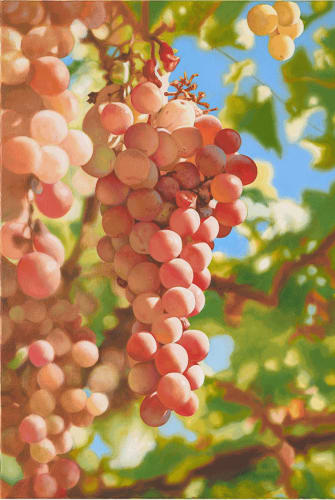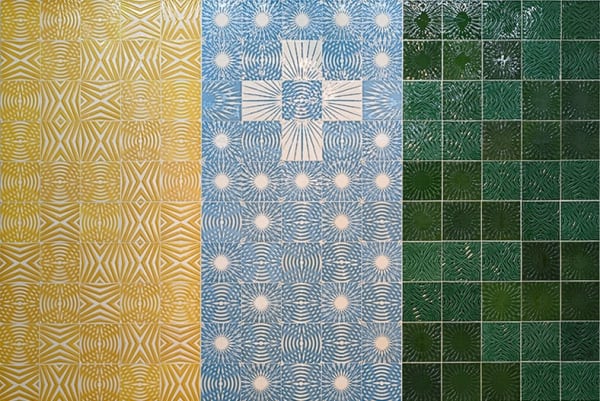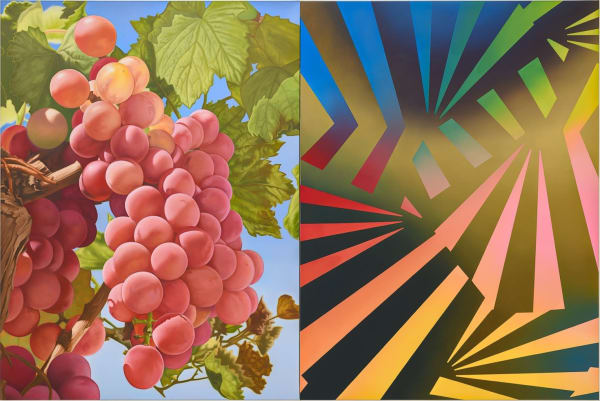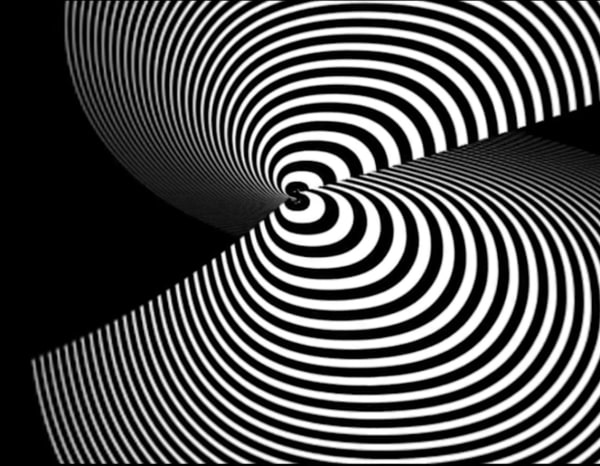Mustafa Hulusi: Cyprus Realism
Pi Artworks London presents Cyprus Realism, its first solo exhibition by the British-Cypriot-Turkish artist Mustafa Hulusi. The show opens Thursday 11th April and runs until Saturday 11th May 2019. Encompassing his persistent enquiry into the topic of ethics and aesthetics, the exhibition will feature new paintings created specifically for the exhibition, alongside a multi-channel video work and a large-scale ceramic tile installation.
Mustafa Hulusi's show Cyprus Realism amalgamates the subjective, objective, universal and cosmic. It is about making visible the cultural stasis of the present whilst simultaneously re-imagining a yet-to-come, temporal vision. With a nostalgia for craft-based technologies, it utilises oil paintings, cathode-ray televisions and handmade ceramics to resolve the dialectical problem that exists between responsibility and authority. It also warns us of the tendencies of technologies and strategies to be co-opted by dominant powers.
Hulusi's botanical paintings, the exhibition's namesake, depict the beautiful yet toxic Oleander plant. Created in a hyper-realist style, and all created within the last year, they call to mind both propaganda images from the early-20th Century to kitsch pastel coloured 1970s art. Rather than replicating an exact photographic image, the paintings attempt to capture a memory and its internal perception. A sense of unease pervades the paintings; these are nostalgic images and express loss. They are an attempt to remember, not just a particular moment of intensity and aliveness, but also self-awareness - the ability to have this conscious thought in the first place. With interiority and objectivity dismantled in a cybernetic dismemberment, the series demonstrates the possible catastrophes present within us. This is not Huxley's Heaven or Hell but a more fundamental attack on subjective ontology.
A sense of disembodiment exists within the video work Mood Reel as itmediates eight points of observation occurring simultaneously, enacting parallel forces of perception. It features film sequences extracted from Third Cinema Films, an example of a medium which emerged from ruling colonial powers and was used extensively, along with radio and television, as a tool of propaganda and conditioning. Indeed the work's title harks back to the praxis of advertising (a 'mood board' is a visual collage still used to this day in advertising and visual design practice). The feeling one gets watching the piece is of being conditioned and programmed. Who is the controller? Is human authority disguised as a vast impersonal self-replicating system, or is any authority actually a systemic cipher?
Hulusi's large-scale installation Ambient (2) continues his fascination with procedural generation, but this time using ceramics. With a small set of computer instructions - a 'procedure' in computer science parlance - a machine acts out a vast range of complex coherent outputs, which is translated onto tiles. Here Hulusi gives us a simulation of pre-Cartesian wholism. A computer maps its outputs in coordinate systems, similar to how ordnance survey maps take the British Isles and force an imaginary grid across it. The very name betrays the military need for measurement and coordination - mapping itself is a first step towards assault or defence. It is almost impossible to find social systems today that do not rely on coordinates, measurement, quantification and calculation. These are all Cartesian technologies. They are not absolute, yet we treat them as such.
Ambient (2), however, is a subversion of Sacred Geometry, the complex and intricate designs of repeated motifs found in Islamic art, rendered only by hand and never calculated by a digital machine or metered rules. They are pre-cartesian and the revelation of beauty is tightly coupled with tool and gesture (compass, straight edge and hand). The implicit fractal order and beauty of creation can only be brought forth by un-calculated method. Thus Hulusi's tiles offer a computed unfolding of splendour. They are artificial, though undeniably concrete and undeniably intoxicating. This is the inverted beauty of a set of laws that violate nature and misrepresent God. They represent the magnificent failure of the Western enlightenment project over the past few hundred years and point towards its end: that people will be produced and generated as embodied extensions of digital logic programs, the final tyranny of calculation and quantification.
About Mustafa Hulusi
Mustafa Hulusi mines his hybrid identity - he was born in London to Turkish-Cypriot parents - to create evocative paintings, installations, films, and photographs. By combining diverse artistic styles and both Middle Eastern and Western art historical references, with a nod to pop culture and mass media, Hulusi investigates how different visual 'languages' shape our perception. His work often investigates the traditional conflation of abstraction and representation in Islamic art and questions how this combination of styles affects viewer perception. In the 1990s, he established his reputation with 'guerilla' poster campaigns, in which he plastered London neighbourhoods with leaflets, posters and original large-scale works. He is currently revisiting this action through his poster campaign at 2 Hoxton Street, which you can follow on Instagram (@musmex) or www.mustafahulusiposters.com
Mustafa Hulusi, b. 1971, London, UK. Major solo exhibitions include; Negative Ecstasy, Dirimart Dolapdere, Istanbul (2016); Recollections of Underdevelopment, Meliksetian I Briggs, Los Angeles (2015); The Empty Near East, Max Wigram Gallery, London (2011); The Empty Near East, The Page Gallery, Seocho-Dong (2011); New Works, Galerist, Istanbul (2011); Afyon, Max Wigram Gallery, London (2011); Mustafa Hulusi and Mark Titchner: The Worshippers, Max Wigram Gallery, London (2009); The Ruins, Civic Room, London (2009); Mustafa Hulusi: Obliteration and Memory, Patrick Painter, Los Angeles (2009); Iznik-Kibris-Londra, Galerist, Istanbul (2008); Ecstasy, Max Wigram Gallery, London (2008); The Cyprus Pavilion, Venice Biennale, Venice (2007); Cennet Bahçesi, A-Foundation, Liverpool (2007); preBuild (a Field of Flowers), Max Wigram Gallery, London (2006); Mustafa Hulusi Too, Rachmaninoff's, London (2005); The End of the West, Max Wigram Gallery, London (2005).
For more information, please contact the gallery at london@piartworks.com or Ece at piartworkslondon@piartworks.com or +442076378403.
-
 Mustafa HulusiCyprus Realism (Verigo Grape 4) SM
Mustafa HulusiCyprus Realism (Verigo Grape 4) SM
2019
Oil on canvas
76 x 51 cm -
 Mustafa HulusiAmbient (5)
Mustafa HulusiAmbient (5)
2013-2019
Ceramic tiles on wediboard mounted on aluminium frame
300 x 450 cm
Unique piece -

Cyprus Realism (Oleander 1) M
2019
Oil on canvas
2 parts, each part 204 x 153 cm -
 Mustafa HulusiCyprus Realism (Grape 5) M
Mustafa HulusiCyprus Realism (Grape 5) M
2019
Oil on canvas
408 x 306 cm, 2 parts,
each 204 x 153 cm -

Mustafa Hulusi
Mustafa Hulusi
Cyprus Realism (Oleander 3)
2019
Oil on canvas
153 x 204 cm -

Mustafa Hulusi
Mood Reel
2016
Video still -

Mustafa Hulusi
Mood Reel
2016
Video still -
 Mustafa HulusiMediterranean Paintings
Mustafa HulusiMediterranean Paintings
2016
C-type archival print
6 parts, each part 41.5 x 56.5 cm (framed)
Edition: 1/3 + 1AP -

Mustafa Hulusi
Nightclubs in Nature
2019
Archival giclee print
8 parts, each part
48 x 48 cm (framed)
Edition: 1/3 + 1AP
Pi Artworks London presents Cyprus Realism, its first solo exhibition by the British-Cypriot-Turkish artist Mustafa Hulusi. The show opens Thursday 11th April and runs until Saturday 11th May 2019. Encompassing his persistent enquiry into the topic of ethics and aesthetics, the exhibition will feature new paintings created specifically for the exhibition, alongside a multi-channel video work and a large-scale ceramic tile installation.
Mustafa Hulusi's show Cyprus Realism amalgamates the subjective, objective, universal and cosmic. It is about making visible the cultural stasis of the present whilst simultaneously re-imagining a yet-to-come, temporal vision. With a nostalgia for craft-based technologies, it utilises oil paintings, cathode-ray televisions and handmade ceramics to resolve the dialectical problem that exists between responsibility and authority. It also warns us of the tendencies of technologies and strategies to be co-opted by dominant powers.
Hulusi's botanical paintings, the exhibition's namesake, depict the beautiful yet toxic Oleander plant. Created in a hyper-realist style, and all created within the last year, they call to mind both propaganda images from the early-20th Century to kitsch pastel coloured 1970s art. Rather than replicating an exact photographic image, the paintings attempt to capture a memory and its internal perception. A sense of unease pervades the paintings; these are nostalgic images and express loss. They are an attempt to remember, not just a particular moment of intensity and aliveness, but also self-awareness - the ability to have this conscious thought in the first place. With interiority and objectivity dismantled in a cybernetic dismemberment, the series demonstrates the possible catastrophes present within us. This is not Huxley's Heaven or Hell but a more fundamental attack on subjective ontology.
A sense of disembodiment exists within the video work Mood Reel as itmediates eight points of observation occurring simultaneously, enacting parallel forces of perception. It features film sequences extracted from Third Cinema Films, an example of a medium which emerged from ruling colonial powers and was used extensively, along with radio and television, as a tool of propaganda and conditioning. Indeed the work's title harks back to the praxis of advertising (a 'mood board' is a visual collage still used to this day in advertising and visual design practice). The feeling one gets watching the piece is of being conditioned and programmed. Who is the controller? Is human authority disguised as a vast impersonal self-replicating system, or is any authority actually a systemic cipher?
Hulusi's large-scale installation Ambient (2) continues his fascination with procedural generation, but this time using ceramics. With a small set of computer instructions - a 'procedure' in computer science parlance - a machine acts out a vast range of complex coherent outputs, which is translated onto tiles. Here Hulusi gives us a simulation of pre-Cartesian wholism. A computer maps its outputs in coordinate systems, similar to how ordnance survey maps take the British Isles and force an imaginary grid across it. The very name betrays the military need for measurement and coordination - mapping itself is a first step towards assault or defence. It is almost impossible to find social systems today that do not rely on coordinates, measurement, quantification and calculation. These are all Cartesian technologies. They are not absolute, yet we treat them as such.
Ambient (2), however, is a subversion of Sacred Geometry, the complex and intricate designs of repeated motifs found in Islamic art, rendered only by hand and never calculated by a digital machine or metered rules. They are pre-cartesian and the revelation of beauty is tightly coupled with tool and gesture (compass, straight edge and hand). The implicit fractal order and beauty of creation can only be brought forth by un-calculated method. Thus Hulusi's tiles offer a computed unfolding of splendour. They are artificial, though undeniably concrete and undeniably intoxicating. This is the inverted beauty of a set of laws that violate nature and misrepresent God. They represent the magnificent failure of the Western enlightenment project over the past few hundred years and point towards its end: that people will be produced and generated as embodied extensions of digital logic programs, the final tyranny of calculation and quantification.
About Mustafa Hulusi
Mustafa Hulusi mines his hybrid identity - he was born in London to Turkish-Cypriot parents - to create evocative paintings, installations, films, and photographs. By combining diverse artistic styles and both Middle Eastern and Western art historical references, with a nod to pop culture and mass media, Hulusi investigates how different visual 'languages' shape our perception. His work often investigates the traditional conflation of abstraction and representation in Islamic art and questions how this combination of styles affects viewer perception. In the 1990s, he established his reputation with 'guerilla' poster campaigns, in which he plastered London neighbourhoods with leaflets, posters and original large-scale works. He is currently revisiting this action through his poster campaign at 2 Hoxton Street, which you can follow on Instagram (@musmex) or www.mustafahulusiposters.com
Mustafa Hulusi, b. 1971, London, UK. Major solo exhibitions include; Negative Ecstasy, Dirimart Dolapdere, Istanbul (2016); Recollections of Underdevelopment, Meliksetian I Briggs, Los Angeles (2015); The Empty Near East, Max Wigram Gallery, London (2011); The Empty Near East, The Page Gallery, Seocho-Dong (2011); New Works, Galerist, Istanbul (2011); Afyon, Max Wigram Gallery, London (2011); Mustafa Hulusi and Mark Titchner: The Worshippers, Max Wigram Gallery, London (2009); The Ruins, Civic Room, London (2009); Mustafa Hulusi: Obliteration and Memory, Patrick Painter, Los Angeles (2009); Iznik-Kibris-Londra, Galerist, Istanbul (2008); Ecstasy, Max Wigram Gallery, London (2008); The Cyprus Pavilion, Venice Biennale, Venice (2007); Cennet Bahçesi, A-Foundation, Liverpool (2007); preBuild (a Field of Flowers), Max Wigram Gallery, London (2006); Mustafa Hulusi Too, Rachmaninoff's, London (2005); The End of the West, Max Wigram Gallery, London (2005).
For more information, please contact the gallery at london@piartworks.com or Ece at piartworkslondon@piartworks.com or +442076378403.


















